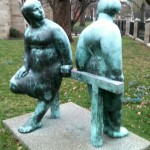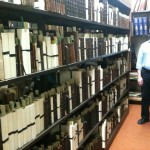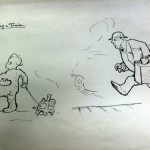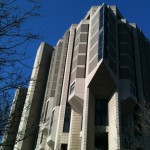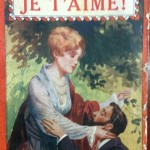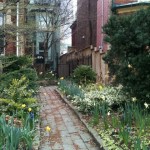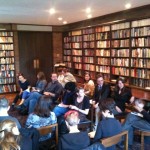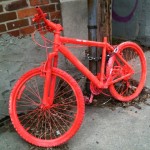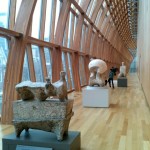E-Reading: A Colloquium at the University of Toronto
Posted on April 26, 2012 in Uncategorized by Eric Lease Morgan
On Saturday, March 31 I presented and attended a colloquium (E-Reading: A Colloquium at the University of Toronto) on the topic of e-reading, and I am documenting the experience because writing — the other half of reading — literally transcends space and time. In a sentence, my Toronto experience feed my body, my heart, and my mind.
Sponsored by a number of groups (The Collaborative Program in Book History and Print Culture, the Toronto Centre for the Book, the Toronto Review of Books, and Massey College) the event was divided into three sections: 1) E-Reader Response, 2) The Space of E-Texts, and 3) a keynote address.
E-Reader Response
Kim Martin (Western University) was honored with the privilege of giving the first presentation. It was originally entitled “Primary Versus Secondary Sources: The Use of Ebooks by Historians”, but sometime before the colloquium she changed the topic of her presentation to the process of serendipity. She advocated a process of serendipity articulated by Jacquelyn Burkell that includes a prepared mind, prior concern, previous experience or expertise, fortuitous outcome, and an act of noticing. [1] All of these elements are a part of the process of serendipitous find. She compared these ideas with the possibilities ebooks, and she asked a set of historians about serendipity. She discovered that there was some apprehension surrounding ebook reading, elements of traditional reading are seen as lost in ebooks, but despite this there was some degree ebook adoption by the historians.
I (Eric Lease Morgan, University of Notre Dame) gave a presentation originally entitled “Close and Distant Reading at Once and at the Same time: Using E-Readers in the Classroom”, but my title changed as well. It changed to “Summarizing the State of the Catholic Youth Literature Project“. In short, I summarized the project, described some of its features, and emphasized that “distant” reading is not a replacement — but rather a supplement — to the traditional close reading process.
Alex Willis (University of Toronto and Skeining Writing Solutions) then shared with the audience a presentation called “Fan Fiction and the Changing Landscape of Self-Publication”. Fan fiction is a type of writing that fills in gaps in popular literature. For example, it describes how the “warp core” of Star Trek space ships might be designed and work. Fan fiction may be the creation of story behind a online multi-player game. These things are usually written by very enthusiastic — “spirited” — players of the games. Sites like fanfiction.net and the works of Amanda Hocking are included as good examples of the genre. With the advent of this type of literature questions of copyright are raised, the economics of publishing are examined, and the underlying conventional notions of authority are scrutinized. Fan fiction is a product of a world where just about anybody and everybody can be a publisher. I was curious to know how fan fiction compares to open access publishing.
The Space of E-Texts
After a short break the second round of presentations began. It started with Andrea Stuart (University of Toronto) and “Read-Along Records: The Rise of Multimedia Modeling Reading”. Stuart presented on the history of read-along books, how they have changed over the years, and what they are becoming with the advent of e-readers. Apparently they began sometime after phonograph player were inexpensively produced and sold because this is when records started to be included in children’s books. They were marketed as time-savers to parents who were unable to read to their children as well as do household duties. She did a bit of compare & contrast of these read-along books and noticed how the stories narrated by men included all sorts of sound effects, but the narrations by woman did not. She then described how the current crop of ebooks are increasingly becoming like the read-along books of yesterday but with significant enhancements — buttons to push, questions to answer, and pages to turn. She then asked the question, “Are these enhancements liberating or limiting?” In the end I believe she thought they were a little bit of both.
“Commuter Reading and E-Reading” was the title of Emily Thompson‘s (University of Toronto) paper. This was a short history of a particular type of reading — reading that happens when people are commuting to and from their place of work. Apparently it began in France or England with the advent of commuting by train, “railway literature”, and “yellow backs” sold by a man named W.H. Smith. This literature was marketed as easy, comfortable, and enjoyable. They were sold in stalls and offered “limitless” choice. Later on the Penguin Books publisher started using the Penguinator — a vending machine — as a way of selling this same sort of literature. Thompson went on to compare the form & function of railway literature to the form & function of current cell phone and ebook readers. It was interesting to me to see how the form of the literature fit its function. Short, easy-to-ready chapters. Something that could be picked up, left off, and picked up again quickly. Something that wasn’t too studious and yet engaging. For example, the very short chapters books designed for cell phone sold in Japan. In the end Thompson described the advent of ebook readers as a moment in time for reading, not the death of the book. It was a refreshing perspective.
Brian Greenspan (Carlton University) then shared “Travel/Literature: Reading Locative Narrative”. While most of the presentations looked back in history, Greenspan’s was the only one that looked forward. In it he described a type of book designed to be read while walking around. “Books surpress optical input,” he said. By including geo-spacial technology into an ebook reader, different things happened in his narrative (a technology he called “StoryTrek”) depending on where a person was located. Readers of the narrative commented on the new type of reality they experienced through its use, specifically, they used the word “stimulating”. They felt less isolated during the reading process because when the saw things in their immediate location they brought them into the narrative.
Keynote address
The keynote address was given by Assistant Professor of Library & Information Science, Bonnie Mak (University of Illinois), and it was entitled “Reading the ‘E’ in E-Reading”. The presentation was a reflection on e-reading, specifically a reflection of the definition of a words on a page, and how different types of pages create different types of experiences. For example, think of the history for writing from marks in clay, to the use of was tablets, to the codex, to the e-reader. Think of the scroll of milleniums past, and think of scrolling on our electronic devices. Think of the annotation of mediaeval manuscripts, and compare that to the annotations we make on PDF documents. “What is old is new again… The material of books engender certain types of reading.” Even the catalogs and services of libraries are effected by this phenomenon. She used the example of Early English Books Online (EEBO), and how it is based on the two Short Title Catalogs (STC) — “seminal works of bibliographic scholarship that set out to define the printed record of the English-speaking world from the very beginnings of British printing in the late fifteenth century through to 1700.” Apparently the STC is incomplete in and of itself, and yet EEBO is touted as a complete collection of early English literature. And because EEBO is incomplete as well as rendered online in a particular format, it too lends itself to only a particular typer of reading. To paraphrase, “Reader, beware and be aware.”
Summary and Conclusions
As I mentioned above, my trip to Toronto fed my body, my heart, and my mind.
The day I arrived I visited with Michael Bramah, Noel Mcferran, Sian Meikle all of the University of Toronto. I got a 50¢ and private tour of the St. Michael’s College special collections including the entire library of the school when it was founded (the Soulerin Collection) as well as their entire collection of G.K. Chesterton and Cardinal John Henry Newman materials. It was then fun trying to find a popular reading item from their Ninetieth Century French Collection. More importantly, we all talked about the “Catholic Portal” and ways we could help make it go forward. That evening had a nice meal in a nice restaurant. All these things fed my body.
My heart was fed the next morning — the day of the colloquium — when I first went to one of the university’s libraries and autographed my WAIS And Gopher Servers book for the fourth or fifth time in the past dozen years. I went to the Art Gallery Of Ontario. There I saw a wall of Dufy’s paintings. I also experienced a curation of some paintings in the style of a Paris salon. This was echoed in the museum’s Canadian collection were similar paintings of similar classic styles were hung as in a salon. My heart soared as I was inspired. The Gallery’s collection and presentation style is to be applauded.
Finally, I fed my mind through the colloquium. Located in an academic atmosphere, we shared and discussed. We were all equals. Everybody had something to offer. There was no goal other than to stimulate our minds. Through the process I learned of my new and different types of reading:
- close reading
- continuous reading
- deviant reading
- distant reading
- distracted reading
- intersectional reading
- location-aware reading
- sustained reading
My conception of reading was expanded. After the event many of us retired to a nearby pub where I met the author of a piece of iPad software called iAnnotate. He described the fluctuating and weaving way features to the PDF “standard” were created. Again, my ideas about reading were expanded. I need and require more of this type of stimulation. This trip was well worth the nine hour drive to Toronto and the twelve hour drive back.






